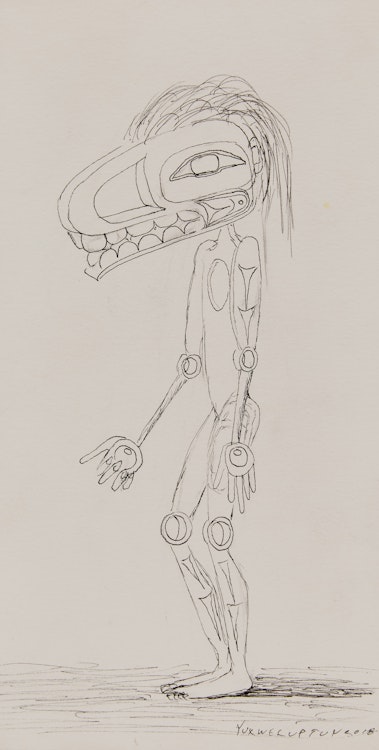Walking Spirit by Lawrence Paul Yuxweluptun

L.P. Yuxweluptun
Walking Spirit
ink on museum board
signed and dated 2018 lower right; unframed
8 x 4.25 ins ( 20.3 x 10.8 cms ) ( card )
Auction Estimate: $1,200.00 - $1,500.00
Price Realized $1,200.00
Sale date: December 15th 2020
A Private Canadian Collection
Share this item with your friends
Lawrence Paul Yuxweluptun
(1957)
Lawrence Paul Yuxweluptun is a Cowichan/Syilx First Nations contemporary artist from British Columbia. He was born in Kamloops in 1957 to a father belonging to the Cowichan Tribes, a Coast Salish First Nation, and a Sylix mother, part of the Okanagan Nation Alliance. Yuxweluptun’s upbringing provided an acute awareness of the issues facing Aboriginal peoples. His parents were very politically active, encouraging their son to pursue a career in politics. He instead chose to create paintings, drawings, and assemblages that address many pressing issues, regarding land claims, damaging assimilationist policies, and environmental degradation.
Yuxweluptun enrolled at the Emily Carr College of Art and Design in the late 1970s and graduated in 1983 with an honours degree in painting. Yuxweluptun is among the most overtly critical artists practicing in Canada today. Yuxweluptun's strategy is to document and promote change in contemporary Indigenous history in large-scale paintings, using Coast Salish cosmology, Northwest Coast formal design elements, and the Western landscape tradition. His work incorporates traditional elements from Northwest First Nations art, as well as evocations of the Canadian landscape painting tradition derived from the Group of Seven. The figures in his paintings are not necessarily representations of real people—or specific Northwest coast beings or ceremonies—but instead comment on the way in which Native identity has been constructed from outside perspectives.

